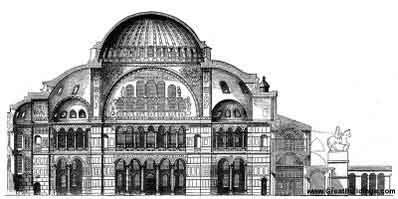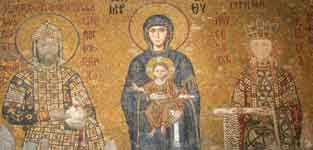.

Hagia Sophia as it appears today

Drawing , c. 1876

A plan of the original architecture of Hagia Sophia, the great church

Hagia Sophia Gaspare Fossati/ Louis Hache
The Church of the Holy Wisdom, commonly known as Hagia Sophia in English, is a former Greek Orthodox church converted to a mosque, now a museum, in Istanbul (Constantinople). It is universally acknowledged as one of the great buildings of the world.
The name comes from the Greek name Αγία Σοφία. It is also known as Sancta Sophia in Latin and Ayasofya in Turkish. (The Turkish and Greek pronunciations sound like a-YEE-ah so-FEE-ah.)
Construction
- Nothing remains of the first church that was built on the same site during the 4th century. Following the destruction of the first church, a second was built by Constantius, the son of - Constantine the Great, but was burned down during the Nika riots of 532. The building was rebuilt under the personal supervision of emperor Justinian I and rededicated on December 27, 537.
Recently Volker Hoffmann and Nikolaos Theocharis claimed that there is a mathematical model behind the Hagia Sophia based on the so-called analemma, a circle inscribed in a square which is inscribed in a circle.
For architects Justinian chose Isidore of Miletus and Anthemius of Tralles, professors of geometry at the University of Constantinople; Anthemius, however, died within the first year. The construction is described in Procopius' On Buildings (De Aedificiis). The Byzantine poet Paulus the Silentiary composed an extant poetic ekphrasis, probably for the rededication of 563, which followed the collapse of the main dome.
Hagia Sophia is one of the greatest surviving examples of Byzantine architecture. Of great artistic value was its decorated interior with mosaics and marble pillars and coverings. The temple itself was so richly and artistically decorated that Justinian is said to have proclaimed "Solomon, I have surpassed thee!" (Νενίκηκά σε Σολομών). Justinian himself had overseen the completion of the greatest cathedral ever built up to that time, and it was to remain the largest cathedral for 1,000 years up until the completion of the cathedral in Seville. It is today the fourth largest cathedral in the world (by size, not height)

Interior of the Hagia Sofia, June 1994
Justinian's basilica was at once the culminating architectural achievement of late antiquity and the first masterpiece of Byzantine architecture. Its influence, both architecturally and liturgically, was widespread and enduring in the Eastern Orthodox, Roman Catholic, and Muslim worlds alike.
|
Hagia Sophia Mosaics
|
|
The Ottoman Restorations and Revisions
Many restorations and repairs were done by Ottoman architects. The most famous and most extensive work was done by the great Mimar Sinan in the 16th century: The dome of the Hagia Sophia was taken down, and a new dome was constructed, the old minarets were also demolished, the minarets were added which can be seen today, as well as Islamic pulpits and art. In the following 400 years, after each sucessive big earthquake and largescale city fire, new repairs and renovations of the Hagia Sophia took place, to conserve it upto today.
Description
Hagia Sophia is covered by a central dome with a diameter of 31 meters (102 feet) and 56 metres high, slightly smaller than the Pantheon's. The dome seems rendered weightless by the unbroken arcade of arched windows under it, which help flood the colorful interior with light. The dome is carried on pendentives—four concave triangular sections of masonry which solve the problem of setting the circular base of a dome on a rectangular base. At Hagia Sophia the weight of the dome passes through the pendentives to four massive piers at the corners. Between them the dome seems to float upon four great arches.
At the western (entrance) and eastern (liturgical) ends, the arched openings are extended by half domes carried on smaller semidomed exedras. Thus a hierarchy of dome-headed elements builds up to create a vast oblong interior crowned by the main dome, a sequence unexampled in antiquity.
The structure has been severely damaged several times by earthquakes. The dome collapsed after an earthquake in 558; its replacement fell in 563. There were additional partial collapses in 989 and 1346. In the era of Süleyman the Magnificent, Mimar Sinan (Sinan the Architect) built extra attachments to prevent it from collapsing.
All interior surfaces are sheathed with polychrome marbles, green and white with purple porphyry and gold mosaics, encrusted upon the brick. On the exterior, simple stuccoed walls reveal the clarity of massed vaults and domes.
Later history
Hagia Sophia was the seat of the Orthodox patriarch of Constantinople and a principal setting for imperial ceremonies. During the Latin Occupation (1204-1261) the church became a Roman Catholic cathedral, and its many treasures and relics were dispersed. It was converted to a mosque after the Fall of Constantinople to the Ottoman Turks under Sultan Mehmed II in 1453. Since more conservative factions of Islam consider the depiction of the human form to be blasphemous, its mosaics were covered with plaster. One must note, however, that due to the foresightedness and tolerance of the Ottoman Sultans, the plaster was periodically removed, the mosaics maintained, and replastered. For almost 500 years the principal mosque of Istanbul, Ayasofya served as model for many of the Ottoman mosques such as the Shehzade Mosque, the Suleiman Mosque, and the Rüstem Pasha Mosque.
Restoration work in the 20th century began in 1932 by the American Byzantine Institute, when most of the figures were uncovered. In 1934, under Turkish president Kemal Atatürk, Hagia Sofia was secularized and turned into the Ayasofya Museum.
Due to its long history as both a church and a mosque, a particular challenge arises in the restoration process. The Christian iconographic mosaics are being gradually uncovered. However, in order to do so, important, historic Islamic art must be destroyed. Restorers have attempted to maintain a balance between both Christian and Islamic cultures.

Justinian I (left) offering the Church of Holy Wisdom and Constantine I (right) offering the City of Constantinople to the Virgin Mary (middle).

Mosaic Icon of Christ Pantocrator.
| Ancient Greece
Science, Technology , Medicine , Warfare, , Biographies , Life , Cities/Places/Maps , Arts , Literature , Philosophy ,Olympics, Mythology , History , Images Medieval Greece / Byzantine Empire Science, Technology, Arts, , Warfare , Literature, Biographies, Icons, History Modern Greece Cities, Islands, Regions, Fauna/Flora ,Biographies , History , Warfare, Science/Technology, Literature, Music , Arts , Film/Actors , Sport , Fashion --- |
Retrieved from "http://en.wikipedia.org"
All text is available under the terms of the GNU Free Documentation License



